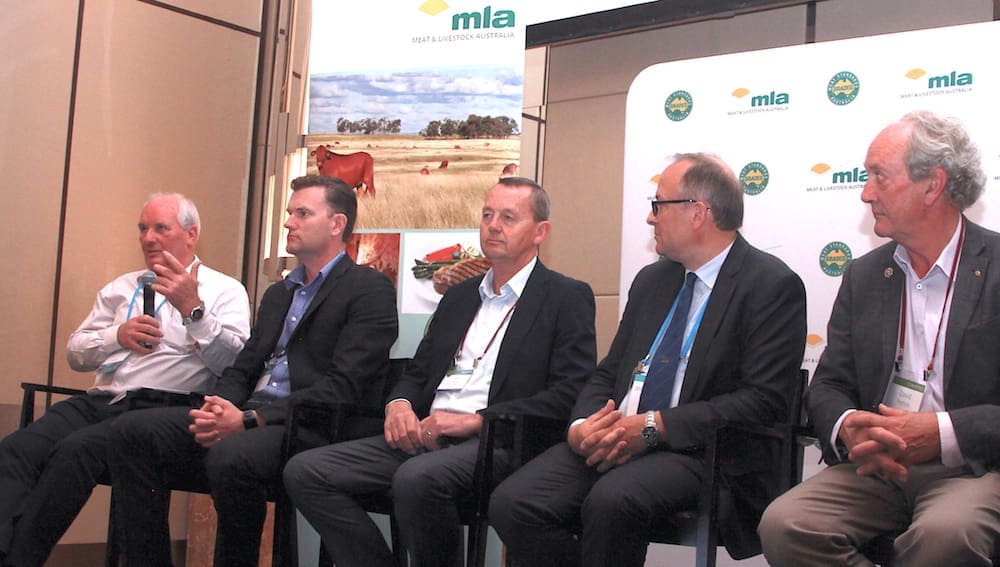Rod Polkinghorne, Michael Crowley, John Webster, Jean Francois Hocquette and David Pethick participate in a panel session during the 20 years of MSA forum in Melbourne.
Twenty years after the creation of the consumer-focused Meat Standards Australia program, meat eating quality pioneer Rod Polkinghorne says while much has been achieved, there is much more that still needs to be done.
“The scary bit is we have been at it for 20 years, but we have really only just started,” he told a forum celebrating 20 years of the MSA program held as part of the International Conference of Meat Science and Technology in Melbourne earlier this week.
Offering his thoughts on where MSA will be in another 20 years, Mr Polkinghorne said that by 2040 beef should no longer be sold by individual cut, such as rump steak or round steak or tenderloin, but by meal outcome descriptions.
Traditional cuts ‘were a nuisance’ because eating quality outcomes could vary dramatically within each cut, and cut names gave consumers little information about the meal outcome they were really seeking.
Data from 97,000 different samples of meat demonstrated a 70 point range in eating quality from best to the worse.
 “So which rump steak did you want, the 30 point one or the 80 point one?,” he asked.
“So which rump steak did you want, the 30 point one or the 80 point one?,” he asked.
What consumers wanted was not a rump steak but a “bloody good meal”, a product that, like any contemporary consumer product, was consistent, simple to purchase, will perform as it is expected to, and for which paying a higher price will equate to higher quality.
Consumers made value judgements when buying an economy or a business class airline ticket or when choosing one of four different types of petrol at the bowser, understanding that a different price provided a different result.
Right now the red meat industry could deliver an experience where consumers could buy meat simply according to what they felt like cooking and eating, and whether the occasion was very special or a good every day meal, by selling on meal-outcomes instead of individual cuts.
“No one wants a fail, you should be able to go straight there and say this is what I want, it is a good average occasion, I want a stir fry, there it is.
“Why would you describe it as anything else? I am sure we will be told there is a whole lot of tradition but that is the reality, we can deliver that sort of simplicity right now in beef.”
Mr Polkinghorne was doing this in his own butcher shop in Melbourne over a decade ago.

The Polkinghorne’s meat retail outlet in Melbourne pioneered the implementation of a ‘whole of supply chain’ branded beef model based on eating quality principles. Under the Polkinghorne brand, a system for branded beef production, processing and retailing was developed, which included deboning, retail cut fabrication and cooked meal production. The concept was built around eating quality outcomes with meat sold on results-based product descriptions. Image: Birkenwood International.
All beef sold in his Polkinghorne’s concept store was produced in a closed supply chain from Mr Polkinghorne’s farm.
The shop had zero cuts.
Instead of selling beef by traditional cut name, it had cabinets that offered beef according to cooking method, such as ‘grills’, with consumers able to choose 5-star grilling meat, 4-star or 3-star.
In 2010 5-star grills were priced at $60/kg, 4-star at $45/kg and 3-star at $23/kg.
“And in that cabinet we actually used to run out of tenderloins, surprise surprise, the dearest thing.
“We said we have another cut (spinalis, or rib eye cap) that will eat the same as tenderloin.
“We ran a survey of our shoppers, we said we can buy in tenderloin that we can’t guarantee because we didn’t grow it, or we can use this other cut, what would you like? The 99 percent response was, ‘use the other cut’.
“So we put 5-star steak out there, some from spinalis, some from tenderloin, and every now and then some from a cube role 5 star, it went in the cabinet at $65 and it always sold, so it can be done.”
Mr Polkinghorne predicted that as the move from a commodity focus to a consumer focus accelerates the reliance on cuts will slowly disappear, replaced by multiple muscles packed under common end use descriptions.
Branded beef meal portions will offer ‘pan ready’ guaranteed outcomes for different cooking styles requiring no cooking knowledge.
‘Ready to Heat’ and ‘Ready to Eat’ meals will also be offered under brand-based eating quality categories supported by provenance and built on an eating quality base.
“We know that cuts are just a damn nuisance, why do we insist on using them?
“What we’re selling here is a result. You look at this pack and it says put it in the oven at 160 degrees for 30 minutes. It has got to be that simple and it can be.
“It is not a quiz, it is not about this is Wagyu, it has this much marbling, it has been aged this long, this is the cut, now you figure out how it is going to eat, and it is your fault if you get it wrong.
“What is the result for God’s sake? You don’t need to know much about a bottle of Coke or a bottle of Pepsi.”
The value to the consumer is simplicity and a guaranteed eating quality outcome with no specialist understanding of meat cuts or cooking knowledge required.
The value to the red meat industry, beyond the critical goal of satisfying consumers, selling more beef and increasing industry revenue, is selling every carcase portion according to its optimum consumer value and realising the full potential value of every carcase.
Branding by flavour
Mr Polkinghorne said the industry also now knows enough about flavour to underpin beef branding in future that will be based on flavour difference.
“I believe we will unscramble flavour enough to be able to say ‘this is a really rich beefy flavour’.
“It might be a really well marbled grainfed animal and it will score say 67 points on a flavour scale, or a milk fed vealer that is 10 months old straight off its mother might score 67 points for flavour too, but it will not taste like the other one.
“So we’re saying okay think of a wheel, this is 67 points for flavour, what is the note, is this a red wine or a white one? Give it to the marketers, how do I describe this sort of flavour? Let’s think of a name, a marketing term, ‘this has got traces of walnuts, it is rich, it is beefy etc…
“If we can get this flavour lexicon out there that is in real consumer terms, we can sell by are they tender, what is the flavour, eating quality, the juiciness – just don’t call it round steak, all round steaks don’t taste the same.
“A round steak from a Brahman bull in northern Australia to a 16-year-old cow in France is not going to taste the same, but if we can drop it into say four categories of basic flavour types, we have really got something we can market, that is the notion we’re heading for.”
‘We’re talking about putting meat that is the same in the same box’
Mr Polkinghorne said the use of objective carcase measurement will also help to reduce the operational complexity that is currently involved in selling meat.
“We’re talking about putting meat that is the same in the same box,” he said.
“So we have three different muscles there and they are all four star stir fry, why do we put a name on the box, why don’t we call it four star stir fry?
“So it is less codes, instead of 10,000 codes it is 1000, 500, a retail cabinet could be 20 not 200.
“So with that simplification where we get back to an outcome, and with value-based payment if we actually pay for those carcases what they’re worth that will drive change, it will improve livestock and product branding and will increase profitability.”

